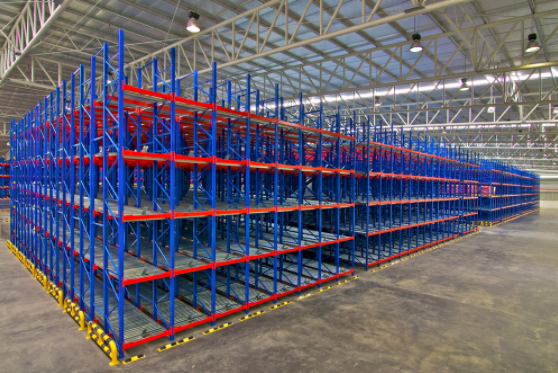Warehouse Shelving and Warehouse Racking
For any warehouse owner, it’s important to know your long span shelving from your cantilever racking.
Warehouse racking and warehouse shelving comes in many different forms. In order to run a safe and profitable warehouse, you’ll need to know about these different forms.
Warehouse Shelving or Warehouse Racking?
The terms warehouse shelving and warehouse racking are often used synonymously. By and large, warehouse shelving tends to refer to smaller storage systems, whereas warehouse racking refers to bigger ones.
Still, HSE offers a better distinction than that. In HSG 76, it defines warehouse racking as “a skeletal framework, of fixed or adjustable design, to support loads generally without the use of shelves”. This would suggest that a warehouse storage system which uses shelves is classified as warehouse shelving, whereas any other kind of warehouse storage system counts as warehouse racking.
HSE does concede, though, that some racking systems might contain shelves as well, expression “generally without use of shelves”. This confuses things somewhat, and it’s probably why so many people refer to both systems as synonyms.
In order to educate warehouse owners on the different systems they’ll be using, we are going to run through the different kinds of warehouse shelving, as well as the different kinds of warehouse racking.
1. Longspan Shelving
The most popular kind of warehouse shelving is longspan shelving. This type of shelving is versatile and incredibly basic. It consists of a flat, long shelf of wood or metal, and a metal skeleton to hold it together. When most people imagine shelving, they imagine the simplicity of longspan shelving.
Longspan warehouse shelving can be modified with extension bays to add more height to the system or with galvanised shelves for refrigerated storage. However, any sort of shelving or racking installation needs to be done by a certified professional or by someone qualified.
What’s more, be sure that any modification of your system does not breach the end user agreement or void the storage equipment manufacturer or producer’s guarantee.
2. Tyre Racking
Tyre racking is sometimes known as tyre shelving. However, as a tyre storage system doesn’t have any shelves, tyre racking is a more accurate description. Like cantilever racking, this system is designed in a way which makes it inconvenient for most kinds of storage, but extremely convenient for certain kinds of storage.
If you store tyres in your warehouse, tyre racking is designed to be the best possible system. It’s the safest, easiest, and best way to store tyres in a warehouse.
3. Clothing System
Just as tyres need a unique storage solution, so too do clothes. It might well be that your clothes are folded and stored in boxes. In which case, longspan shelving or pallet racking would suffice. However, for hanging clothes, there are specific systems out there.
Adjustable Pallet Racking
If longspan racking is the most popular and versatile warehouse shelving system, adjustable pallet racking is the most popular and versatile racking system. Instead of shelves, adjustable pallet racking uses pallets which can be adjusted vertically. This allows for a wide variety of storage.
Of course, sometimes, a generic system isn’t the best. This is why cantilever racking and other storage systems exist. Still, for a business which stores a variety of items, pallet racking systems remain immensely popular.
Mezzanine Racking System
A mezzanine racking system is a storage system with stairs and walkways which allow staff members to climb the system, but only in a very specific way. This is the only kind of racking system which can be climbed on, which is why there are strict guidelines regarding the load-bearing capacity.
Drive-Through Racking
For warehouses which use forklifts or other kinds of vehicles, drive-through racking is a great option. It’s designed to allow for the safe passage of vehicles, but drivers should still take extra care when operating a vehicle in a warehouse.
This means using rack protectors correctly, as outlined in HSE HSG76, by only using them as a last resort and it also means referring to the Lifting Operations and Lifting Equipment Regulations (LOLER) 1998.
Cantilever Racking
Pretty much all racking systems are variations on a pallet racking system. The most notable exception to this a cantilever racking system. A cantilever racking system consists of arms instead of pallets. The result is the ability to store long, thin objects — like timber or steel beams — much better than a pallet racking system could.
Because cantilever racking systems are specialist, they require specialist inspectors. The SEMA Approved Racking Inspector (SARI) from Storage Equipment Experts is one of the only SARIs to be qualified by SEMA to inspect cantilever racking as well as all kinds of pallet racking.
For inspection or inspection training on warehouse shelving or any kind of warehouse racking, contact Storage Equipment Experts. Phone us for a FREE consultation and for nationwide coverage for the whole of the UK and nationwide coverage for the whole of Ireland, too.

